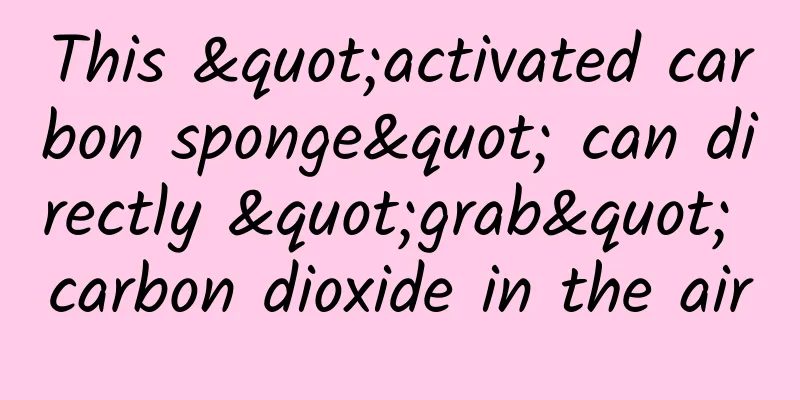This "activated carbon sponge" can directly "grab" carbon dioxide in the air

|
Produced by: Science Popularization China Author: Guo Fei (Yantai University) Producer: China Science Expo Editor's note: In order to understand the latest developments in cutting-edge science and technology, the China Science Popularization Frontier Science Project has launched a series of articles titled "Understanding Top Science Journals", which selects outstanding papers from authoritative journals and interprets them in plain language as soon as possible. Let us broaden our scientific horizons and enjoy the fun of science through the window of top journals. The impact of climate change on human society and the natural environment is becoming more and more significant. Reducing greenhouse gas emissions and mitigating the greenhouse effect has become a global consensus. Governments and the scientific community are actively exploring various solutions, and carbon dioxide capture and storage technology is one of the focuses that has attracted much attention. Recently, a research team at the University of Cambridge has developed a new method to use modified activated carbon to efficiently and cost-effectively capture carbon dioxide from the atmosphere. This breakthrough provides new possibilities for addressing the increasingly severe problem of global warming and achieving the goal of carbon neutrality. Comparison of proposed CO2 sequestration worldwide (grey series of all different depths) versus what has been achieved (blue series of all different depths). Sequestration at natural gas processing plants is over 75% achieved, other industrial projects are around 60% and power plants are around 10%. (Image source: Wikipedia) Activated carbon: the "secret weapon" in home water filters Activated carbon, also known as activated carbon or activated carbon, is a porous substance made of carbon materials. It is usually made by carbonizing carbon-rich raw materials such as wood, coal, coconut shells, etc. under high temperature and oxygen-free conditions. During the carbonization process, non-carbon elements in the raw materials are removed and a large number of micropores are formed inside, which makes the activated carbon have a large specific surface area and excellent adsorption properties. The porous surface of activated carbon (Image source: Wikipedia) One of the most common applications of activated carbon is in household water filters. It can effectively remove various pollutants such as chlorine, organic matter, heavy metal ions, etc. in water, providing clean and healthy drinking water. In addition to the field of water purification, activated carbon is also widely used in many industries such as air purification, food processing, and chemical production. Its strong adsorption capacity comes from its unique porous structure: the surface area of each gram of activated carbon can reach 500-1500 square meters, equivalent to the area of two tennis courts. This highly developed pore structure enables it to adsorb and fix a large number of gas, liquid or solid molecules. Schematic diagram of activated carbon adsorbing dye (the cup on the right shows the state before adsorption) (Image source: Wikipedia) It was the excellent adsorption performance of activated carbon that inspired the Cambridge University research team. They imagined that if activated carbon could be modified to improve its selective adsorption capacity for carbon dioxide, an efficient and economical carbon capture technology could be developed. Therefore, they tried to apply a specific electric field to the activated carbon in a similar way to charging a battery, so that the surface of the activated carbon is enriched with charges, thereby enhancing the attraction to the charged carbon dioxide molecules. This is the core principle of the "charged activated carbon sponge" technology. "Capturing" carbon dioxide: the "last resort" to combat climate change In order to curb the trend of global warming, the Paris Agreement proposes the goal of limiting the global average temperature rise within 2°C this century and striving to limit it to 1.5°C. This means that humans must achieve net zero carbon dioxide emissions in the second half of this century, that is, to achieve a balance between carbon dioxide emissions and removal through emission reductions and carbon capture. However, it is far from enough to control carbon dioxide emissions by reducing fossil fuel use, improving energy efficiency and other emission reduction measures. According to the Intergovernmental Panel on Climate Change (IPCC), in order to achieve the 1.5°C temperature control target, in addition to drastically reducing emissions, we also need to remove 5 billion to 11 billion tons of carbon dioxide from the atmosphere every year by 2050. Currently, afforestation is the most commonly used method of carbon removal, but its potential is limited and it is difficult to meet such large-scale needs. Therefore, the development of efficient and scalable carbon capture and storage technology has become a top priority. Dr. Alexander Fowles, the leader of the "Charged Activated Carbon Sponge" research, admitted that capturing carbon dioxide from the atmosphere should be the "last resort" to combat climate change. After all, this post-remediation method is more expensive and less efficient than reducing emissions at the source. "But given the severity of the climate crisis, this is a direction we must explore." Dr. Fowles emphasized: "Realistically speaking, we must do everything we can." In fact, carbon capture and storage (CCS) technology has become one of the important options for the international community to address climate change. Governments and companies are increasing their investment and deployment of CCS. The International Energy Agency predicts that by 2050, CCS will need to contribute about 13% of global emissions reductions. However, most current CCS technologies are aimed at large point sources such as power plants and steel mills, but there is a lack of economical and efficient means to capture dispersed mobile sources and carbon dioxide in the existing atmosphere. This is exactly the motivation for the research on "charged activated carbon sponge". Method of using terrain and environment to absorb and fix carbon dioxide emitted by thermal power plants (Image source: Wikipedia) “Charging” activated carbon: simpler and more efficient Traditional CO2 capture materials, such as amino-functionalized porous silica gel and metal-organic frameworks, usually need to be regenerated at temperatures as high as 900°C to release the adsorbed CO2 for storage. This is not only energy-intensive but may also lead to rapid degradation of material performance. In contrast, the "charged" activated carbon sponge developed by the Cambridge University team showed obvious advantages. The study found that after the activated carbon that has been "charged" has adsorbed carbon dioxide, it only needs to be heated to 90-100°C to effectively release the captured carbon dioxide. This temperature is much lower than that of traditional materials and can be achieved through industrial waste heat or renewable energy (such as solar energy, geothermal energy, etc.), so it is more environmentally friendly and energy-saving. In addition, this heating process starts from the inside of the material, avoiding local overheating on the surface and further improving energy efficiency. So how does "charging" enhance the ability of activated carbon to adsorb carbon dioxide? The researchers explained that applying an electric field introduces additional charges on the surface of activated carbon, causing it to exert a stronger electrostatic attraction on polar carbon dioxide molecules. At the same time, the electric field may also change the pore structure of activated carbon, providing more dwelling points for the adsorption of carbon dioxide molecules. The combined effect of these mechanisms significantly improves the adsorption capacity and selectivity of charged activated carbon for carbon dioxide. It is worth mentioning that the "charging" process itself is not complicated. The research team used a device similar to a lithium-ion battery, with activated carbon as the positive electrode and metallic lithium as the negative electrode, and an electrolyte filled between the two. Through the application of external voltage, lithium ions are embedded on the surface of the activated carbon to form a surface charge. This device is simple in design and easy to operate, and is expected to achieve low-cost, large-scale production. Schematic diagram of the process of "charging" the activated carbon network (Image source: Reference 1) Challenges and Prospects Although "charged activated carbon sponge" performs well in carbon dioxide capture, there are still some challenges to overcome to truly achieve industrial application. The first is to further improve the adsorption capacity. At present, each gram of charged activated carbon can adsorb up to 3-4 mmol of carbon dioxide, which is still a certain distance from the theoretical maximum value. The research team is improving the adsorption performance of activated carbon by optimizing its pore structure, surface chemical properties and other methods. The second issue is the long-term stability of the material. Repeated adsorption-regeneration cycles may lead to performance degradation such as activated carbon pore collapse and surface charge loss. How to ensure that the material can still maintain efficient adsorption after repeated use is a difficult problem that needs to be overcome. The researchers plan to enhance the structure and chemical stability of activated carbon through surface coating and doping. In addition, the scale-up application of technology also faces many challenges, such as reactor design, system integration, cost control, etc. Scaling up laboratory sample preparation to industrial production requires optimization and innovation in materials, processes, equipment and other aspects, which requires concerted efforts and continuous investment from industry, academia and research. Despite the challenges, the "charged activated carbon sponge" technology is still encouraging. It points out a new direction for the development of more efficient and environmentally friendly carbon capture materials. Dr. Fowles said that this strategy is not limited to activated carbon, but can also be extended to other porous material systems for gas separation and purification in different fields. As one of the key paths to achieve carbon neutrality, CCS is receiving high attention from governments, industry and academia. The advent of "charged activated carbon sponge" has undoubtedly injected new vitality into this field. Its simple, efficient and economical characteristics are expected to promote the development and popularization of CCS technology and contribute to human society's response to climate change challenges. References: 1. Capturing carbon dioxide from air with charged-sorbents. Huaiguang Li, Mary E. Zick, Teedhat Trisukhon, Matteo Signorile, Xinyu Liu, Helen Eastmond, Shivani Sharma, Tristan L. Spreng, Jack Taylor, Jamie W. Gittins, Cavan Farrow, S. Alexandra Lim, Valentina Crocellà, Phillip J. Milner & Alexander C. Forse 2. Scientists charge 'charcoal sponge' to soak up CO2. BBC News 3. Cambridge researchers unveil 'electric sponge' to capture CO2. Dominic Ellis 4. Science and Technology Daily: Is there any way to directly “capture” carbon dioxide from the air? |
<<: @Teachers, students and parents: 42 summer safety tips, must read!
>>: They hammered away, hammer after hammer, and made a surprising discovery
Recommend
Top 10 GitHub open source iOS libraries to speed up app development
【51CTO.com Quick Translation】iOS is one of the mo...
Event planning and promotion丨A universal event planning solution!
There is actually no shortcut to planning an even...
Red alert! Super Typhoon Dusurui is coming with great force. How can we defend ourselves scientifically?
"Du Su Rui" is here! The Central Meteor...
Tonga volcano erupts, but the spewing of hot magma could cause global temperatures to drop?
Recently, the Hunga Tonga volcano (20.5°S, 175.4°...
Baidu launches smart mini-programs, which industries will benefit from it?
When it comes to mini programs , Baidu, which sta...
Taobao’s Double Eleven operation routines, why are users willing to share?
In 2018, Double Eleven is about to celebrate its ...
The most detailed explanation of Toolbar development in history, this is a must-read!
Introduction to Toolbar Toolbar is a new control ...
50 tricks of cross-border marketing
No matter how the market environment changes, cro...
Where should I sit on a plane? Is there really a "safest seat" on an airplane?
Nowadays, more and more friends choose to travel ...
Why do so many brands do year-end reviews, and NetEase and Alipay dominate the screen?
It is the end of the year again, and brands from ...
"Rod" for smart devices and shout innovative sound "Rod" speaker experience
The increasing popularity of smart products has p...
This year's Qixi marketing, big brands are doing it this way
It’s Chinese Valentine’s Day again! ! ! Such dog-...
Why do all the unearthed Terracotta Warriors have single eyelids? It may be due to these two reasons →
A reporter recently learned from the Qin Shihuang...
Suddenly found yourself with bloating and a thick waist? It may be this disease, be alert!
Ms. Wang, 52, suddenly found that her waistline h...
Lei Jun's three-hour talk: I don't have time to worry
[[134230]] Every once in a while, this star entre...









